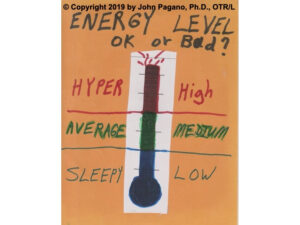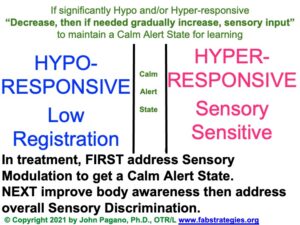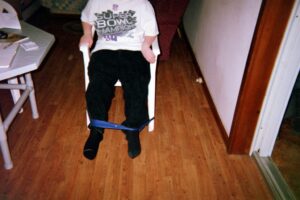School occupational therapists apply sensory-based interventions (SBIs) providing specific sensory input for improved classroom behavior. SBIs can include school occupational therapy teacher consultation, environmental adaptations, adaptive equipment, and the use of specific sensory activities Basic SBI Efficacy Post. It is important to differentiate occupational therapy SBIs using individualized goal-directed SBIs to objectively improve behavior (FAB Videos of SBIs) from SBIs not involving an occupational therapist (Watling et al., 2011).
It is also important to distinguish occupational therapy using sensory-based interventions (SBIs) from Ayres Sensory Integration Therapy (SIT). OT SBIs and SIT are both occupational therapy interventions based on sensory integration theory, but are different interventions that have distinct research support. Sensory Integration therapy (SIT), also referred to as Ayres Sensory Integration® (ASI), is the specific use of individualized child-directed activities that adhere to designated core concepts involving the use of sensory interactions to facilitate an adaptive response (Schaaf & Mailloux, 2015).
SIT is not considered an appropriate occupational therapy model for use in many school systems. However, medical referrals for SIT can be extremely helpful for student who do well at school but demonstrate inappropriate behavior when they get home. Clinic occupational therapy involving SIT can also be helpful for reducing stress and improving behavior in some students immediately following transitions such as discharge home from a psychiatric hospital.
Sensory-based interventions (SBIs) are a useful component of school occupational therapy practitioners efforts to help reduce the use of seclusion and restraint in schools NEWSchoolOTCrisisResponsePrevention SBIs can help achieve objective behavioral improvement by addressing specific sensory modulation challenges.
Sensory modulation is the ability to respond to functionally relevant sensory information while screening out functionally irrelevant information (Watling et al., 2011). Sensory modulation disorders are both distinct from and significantly more likely to co-occur in students with mental health, Post-Traumatic Stress, and Autism Spectrum Disorder. SBIs can significantly improve self-regulation and reduce distress in students with complex behavioral challenges by teaching them to monitor and regulate their arousal level for improved behavior.
Students who have sensory modulation disorders can be taught to notice whether their arousal level is too high (hyper and fidgety interfering with learning) or too low (sleepy and sluggish) for learning, then use coping strategies to change their arousal related behavior to a more functional level. Most students learn best in a quiet alert state rather than when they are overly excited or lethargic.
One method for assessing student’s energy level used in the ARC trauma program is depicting where in their body house their energy level is. The drawing below is a teen who was sad depicting that since getting out of bed and coming to OT her energy level has “just left the basement”.

Maintaining an appropriate arousal level involves sensory, social and behavioral skills. Using sensory modulation skills for appropriate behavior requires the social skills to understand their current arousal level and the unique expectations of differing school environments (e.g., there are usually higher arousal level expectations in physical education than in reading class).
Once a student identifies his current behavior of running around and shouting during reading class as a problem, he must have the sensory and behavioral skills to engage in sensory coping strategies that lower his arousal level. While therapists, teachers and parents initially help students recognize and reward them for modulating their arousal levels for improved behavior, the ultimate goal is to teach students to independently regulate their arousal levels for school learning.
It is helpful for school occupational therapy practitioners using SBIs to consult with teachers, social workers, speech/language pathologists and behaviorists when applying SBIs. Occupational therapy using SBIs can be integrated with school Positive Behavioral Support and the Pivotal Response Training behavioral frame of reference to use sensory coping strategies that are embedded in classroom routines.
Pivotal Response Training offers a child-centered behavioral approach that integrates well with occupational therapy using SBIs to improve school behavior. Pivotal Response Training uses applied behavioral analysis to developmentally address motivation, interactions, and generalization of skills. Rather than say “swing” and be given food as a reinforcement, a student would say “swing” and immediately be pushed on the swing (Stahmer et al., 2010).
School occupational therapy practitioners have the unique skills to help students understand and regulate their specific sensory modulation challenges to achieve school goals of improve behavior for learning. SBIs offer occupational therapy practitioners a tool for expanding their role in schools beyond (Tier 3) individual treatment. SBIs can also be provided through (Tier 2) targeted small group and (Tier 1) school wide interventions.
An example of a Tier 1 school wide intervention is an occupational therapy bulletin board developed to introduce occupational therapy and the use of sensory-based interventions for improved self-control to the school. This therapist asked students to identify the “popular kids”, and after getting consistent responses invited these students to volunteer to contribute their hand prints and first name to the occupational therapy bulletin board. The board described wall pushups as a way of modulating high arousal levels that were negatively impacting behavior. With teacher prompting students were invited when they passed by the occupational therapy bulletin board to do wall pushups in the hands of their favorite “popular kid”.

Case Study of School Occupational Therapy Using SBIs
School occupational therapy practitioners can help students understand and regulate their unique sensory modulation challenges to achieve school goals of improved behavior for learning. “Robert” was a kindergarten student referred for an occupational therapy evaluation to address his inability to remain seated. His teachers reported that Robert was a motivated student with good intelligence but that his inability to remain seated for five consecutive minutes would interfere with his ability to succeed in first grade, where the teacher expected students to maintain seated attention for a minimum of two consecutive hours.
The Short Sensory Profile 2 (Dunn, 2014) rated by the kindergarten teacher, was included as a component of Robert’s occupational therapy evaluation. His scores indicated much more than others Sensitivity, Registration, and Sensory as well as just like the majority of others Seeking, Avoiding, and Behavioral. Based on the Short Sensory Profile 2 as well as other evaluation findings, school occupational therapy services including SBIs was recommended to address the goal of maintaining seated attention for fifteen consecutive minutes.
Occupational therapy services included both direct intervention and consultation with the teacher and Robert to increase awareness of strategies to increase seated attention.
The visual support shown below was used to guide their understanding of Robert’s sensory modulation challenges and guide strategies for using SBIs to improve seated school attention. Consultation was initially directed at using pictures for identifying whether Robert’s arousal level was in the quiet alert state, too hyper or too hypo-responsive for appropriate seated attention FAB Arousal Level Strategy

When Robert or his teacher noticed he was too hypo or hyper-responsive to stay seated they would decrease, then if needed sequentially increase sensory input until he could resume sitting.

This visually supported decrease, then if needed gradually increase sensory input to maintain a quiet alert state strategy can be useful for guiding teachers and students in adjusting arousal levels for learning. During individual occupational therapy specific SBIs were tried, and those that helped Robert maintain seated attention were taught to him and his teacher.
When Robert became too hyper or hypo-responsive to remain seated the environmental stimuli was initially reduced (e.g., by lowering extraneous classroom noise levels and having Robert wear noise canceling headphones). If a quiet alert state was not adequately achieved for him to resume sitting, sensory input was incrementally increased from this lowered level until he could resume sitting (e.g.. the teacher used color lined paper for reading then placed Theraband on Robert’s chair legs so he could get deep pressure input by kicking).

The specific SBIs described above were based on evidence-based clinical reasoning during classroom observations and found to improve seated attention. Clinical reasoning that led to lowering extraneous classroom noise levels and using noise cancelling headphone was based on research suggesting that students with sensory sensitivity were significantly more distracted by auditory input due to decreased neurological habituation (Green et al., 2015) and showed improved learning given reduced noise distractions (Kinnealey et al., 2012). The use of color lined paper was tried based on research suggesting that adding colored cues can enhance reading (Zentall et al., 2013). Finally, the SBI of tying Theraband to the legs of the chair was based on sensory integration theory suggesting that providing proprioceptive input helps organize behavior (Schaaf & Mailloux, 2015).
School occupational therapy practitioners can apply specific goal-directed SBIs to improve student behavior. SBIs can be used not only in individual occupational therapy intervention, but in small group and school wide interventions. It is important to give school staff an understanding of occupational therapy using SBIs to improve behavior for participation in classroom learning tasks (Watling et al., 2011).
References
Dunn, W. (2014). Sensory Profile 2. Bloomington, MN: Pearson.
Green, S. A., Hernandez, L., Bookheimer, S. Y., & Dapretto, M. (2016). Salience network connectivity in autism is related to brain and behavioral markers of sensory overresponsivity. Journal of the American Academy of Child & Adolescent Psychiatry, 55(7), 618-626.
Green, S. A., Hernandez, L., Tottenham, N., Krasileva, K., Bookheimer, S. Y., & Dapretto, M. (2015). Neurobiology of sensory overresponsivity in youth with autism spectrum disorders.
Kinnealey, M., Pfeiffer, B., Miller, J., Roan, C., Shoener, R., & Ellner, M. L. (2012). Effect of classroom modification on attention and engagement of students with autism or dyspraxia. American Journal of Occupational Therapy, 66, 511–519.
Schaaf, R. C. & Mailloux, Z. (2015). Clinician’s guide for implementing Ayres Sensory Integration: promoting participation for children with autism. Bethesda, MD: AOTA Press.
Stahmer, A. C., Suhrheinrich, J., Reed, S., Bolduc, C., & Schreibman, L. (2010). Pivotal response teaching in the classroom setting. Preventing School Failure: Alternative Education for Children and Youth, 54(4), 265-274.
Watling, R., Koenig, K., Davies, P. & Schaaf, R. (2011). Occupational therapy practice guidelines for children and adolescents with challenges in sensory processing and sensory integration. Bethesda, MD: AOTA Press.
Zentall, S. S., Tom-Wright, K., & Lee, J. (2013). Psychostimulant and sensory stimulation interventions that target the reading and math deficits of students with ADHD. Journal of attention disorders, 17(4), 308-329.

Please change my email address to: amamaouellette@gmail.com
Thanks!
Anna Ouellette
Pingback: Sensory Corner: Sensory-Based Interventions in School-Based OT | PediaStaff Pediatric SLP, OT and PT Blog